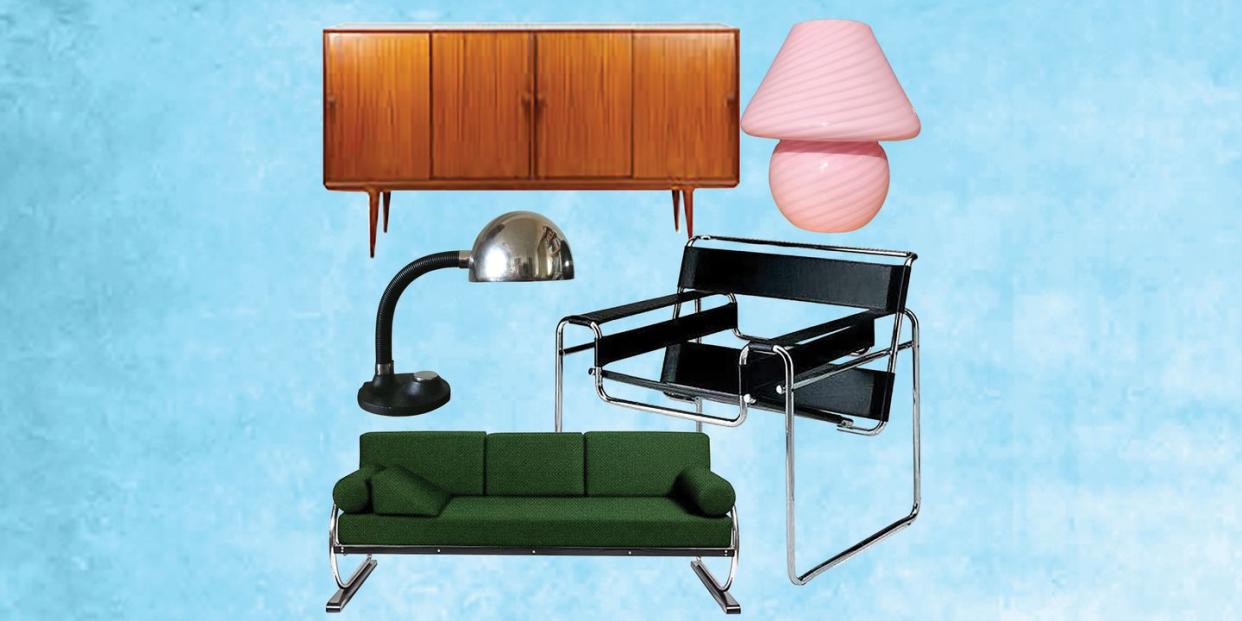How I Furnished My Entire Home Without Buying Anything Brand New

After years of living in furnished sublets complemented with accents found on sets, the year-long quarantine finally forced me to stay in one place: an unfurnished apartment far away from my much-beloved family garage and the collection of random career souvenirs buried within it. But, with both an effort at sustainability and a tight pandemic budget in mind, I was determined not to shell out thousands on a bunch of new furniture (especially given current delivery delays). So, I vowed to entirely furnish my new apartment with found, made, or secondhand furniture.
To make things easier, I pulled inspiration based on material, color, and shape rather than lusting over specific pieces that would be hard to find secondhand. A scale digital blueprint of my new place allowed for specific measurements and a budget sheet provided quick adjustments should I find a one-of-a-kind item or a slate of essentials on a stoop. Here are my biggest takeaways.
Craiglist Is (Still) King
There are enough stooping blogs to cover every corner of New York’s 5 boroughs, but an under 600 sq. ft. apartment didn’t suit major conversions. Plus, my outer-borough location didn’t make driving around the city for hours super sustainable.
Instead, Craigslist and its latest competitor Facebook Marketplace remained an important staple—with a few caveats. The key is not to scroll hours on end without purpose. Use keywords around design styles like “mid-century modern” or “Bauhaus” to narrow down options. Not interested in an original piece? Listers will often add similar keywords in postings to attract buyers. Try typing in “Breuer style” instead of “Wassily chair” to pull up similar materials as the late designer without the exact chair worth upwards of $3,000.
Since I was designing with a materials palette in mind, searching “chrome,” “walnut,” and “enamel” helped bring up searches from those letting go of old pieces or salvage sellers that weren’t hawking antiques. More than a few pieces were from older collectors who were more concerned about re-homing their pieces than selling to the highest bidder.
Love knowing all the latest design trends? We’ve got you covered.
Getting Out of the City Is a Must
You’re more likely to find the exact lighting fixture you want in a big city, but if you’re on a budget or are open to similar silhouettes, venture out to wider pastures. I picked two cities to run through and tried to source from thrift shops before I arrived. An artist’s newsletter famous for job postings and prop selloffs led me to my favorite chairs in a reclaimed school down in Philadelphia. An estate sale posted on Facebook Marketplace sent me upstate for nearly all of my storage pieces.
Scope out a neighborhood before renting out that cargo van. Do they have a crafts market on the weekend? How often are people moving (Is it a summer destination? A college town?) Are there a lot of artist studios that sell excess materials? My upholstery fabric had to be salvaged (see rules above), so fabric recyclers, design studios, and artists' spaces were frequent requirements. Kitchen chairs were re-wrapped in quilted linen scraps, throw pillows were made from misprinted yukata scraps.
Prop Houses Are Hidden Gems
Most major cities have at least one prop house constantly recycling furniture, decor, and set pieces. If you’re living in the big three (NY, LA, ATL) you’ll have your pick of houses rotating their stock of items that are infrequently rented or overstocked (modern pieces, custom designs, etc.). Some prop houses will reach out to stylists and art departments with a list of purchasable items, but many have a sale section of their rental catalog ready for purchase in the off-seasons.
Before tuning in to the Oscars (notoriously dead season for filming), scroll on a few of your city's prop pages to find gems like authenticated period pieces in pristine condition or heavily discounted modern furniture that needs a little love.
Instagram Is the New Thrift Shop
The first time I stumbled on my childhood thrift store’s Instagram, I immediately dropped it in the family chat. The tiny Queens community hub with its vinyl in the front and rack of funky fashion in the back was the latest neighborhood haunt that had taken to advertising its new arrivals on Instagram.
Some shops will let you hold a piece from a posting, while others have used Instagram's shopping feature to allow for seamless checkout in between interiors inspiration.
Smaller thrift accounts source products by style or era. As you narrow down an aesthetic for your space, find a thrifter that specializes in it and find similar accounts by scrolling through follow lists or checking their tags. Once a vintage item is purchased, it's hard to find again, so check shop's stories for a chance to snap it up before the post proclaims it sold.
Mixing Is Your Best Friend
Now that you've curated a selection of perfectly sized pieces to fit your place, how do you make them all mesh? Since my theme was materials and shape-based rather than era, I stuck to the rule of three.
When mixing wood tones, shapes, or colors always find three ways to incorporate them. If your sideboard is pine, but your sofa is a trendy green velvet, try pine frames on the wall, and a similarly toned bowl on the coffee table. Black kitchen chairs in an all-white kitchen? Try black dish towels, an onyx vase, or darker pendant lighting.
Either way you mix it, by sourcing things you truly love and that are guaranteed to be one-of-a-kind you'll build a home that feels uniquely you in a way that's sustainable and small business-friendly.
Follow House Beautiful on Instagram.
You Might Also Like

